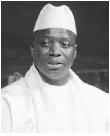THE GAMBIA
Yahya A. J. J. Jammeh
President

(pronounced "YAH-ya JA-may")
"Our future and destiny lie squarely in our hands and certainly in agriculture."
The Republic of the Gambia is named after the River Gambia which flows the length of the country's territory, extending eastward about 470 km (292 mi). Nestled on the sides of the banks of the river, The Gambia's land area of 11,295 sq km (4,361 sq mi) measures only about 24 km (15 mi) in width for most of its length and 50 km (31 mi) at its widest point. The country is surrounded by Senegal on its northern, southern, and eastern borders, and the Atlantic Ocean to the west. The Gambia's population was estimated at 1.45 million in 2002, with more than 63% living in rural areas. Principal ethnic groups include the Mandinka (39.6%), Fula (18.8%), and Wollof (14.6%). About 85% of the people are Islamic, and most of the remainder are Christian. English is the official language, but Mandinka, Fula, Wollof, Jola, Serahula, and Serere are also spoken. Agriculture, forestry, and fisheries provide employment and income for almost 85% of the population. Groundnuts are the most important cash crop though tourism is the major source of foreign exchange. In 2001 the per capita gross domestic product (GDP) was estimated at US $1,770. The currency is the dalasi. The 2002 United Nations Human Development Report ranked The Gambia 160 out of 173 countries on the basis of real GDP per capita, adult literacy (47.5%), and life expectancy (54 years).
ADDRESS
Office of the Chairman
State House
Banjul
Republic of The Gambia
Comment about this article, ask questions, or add new information about this topic: